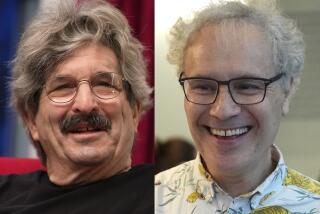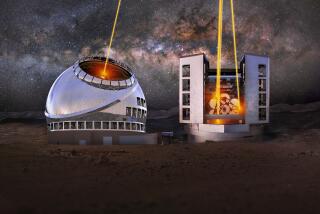SCIENCE FILE / Q
Wendy Freedman, director of the Carnegie Observatories in Pasadena, and two colleagues were named this month as recipients of the $500,000 Gruber Prize, one of the world’s top awards in the field of cosmology.
Freedman, along with Robert Kennicutt and Jeremy Mould, were honored for their nearly decade-long effort to find a more precise value for the Hubble constant, one of the key values in cosmology, a measure of how fast the universe is expanding and thus how old it is.
The Freedman team’s work helped scientists to arrive at the currently accepted age of the universe: 13.7 billion years.
Freedman discussed her research in the Carnegie offices where astronomer Edwin Hubble made his measurements nearly a century ago.
--
What is the Hubble constant?
Edwin Hubble discovered in 1929 that the universe was expanding. He made that discovery in two parts. He first found that there were galaxies outside and in addition to our own Milky Way galaxy. At that time, it hadn’t been known there were other galaxies. For the first time, Hubble was able to measure the distances to these objects. Then he showed they were all taking part in the expansion of the universe. Based on Einstein’s general theory of relativity, if you can measure how fast the universe is expanding, you can run the model backward and find out how long it’s been expanding and how big the universe is. The faster the current expansion rate, the younger and the smaller the observable universe.
--
So the Hubble constant is a measure of the expansion rate of the universe?
Right, the current expansion rate. But it turned out to be much more difficult than expected to measure the Hubble constant. Hubble’s original value [500 km/sec/Mpc] was off by at least a factor of seven. [1 Mpc=1 Megaparsec, or 3.26 million light years.] For decades before [our project] the uncertainty had remained a factor of two.
--
That’s a lot of error.
That’s right. And since so many other things in astronomy depend on knowing the exact distance scale of the universe, this big uncertainty with the Hubble constant was a real problem in cosmology. Especially when it came to understanding and locating stars and galaxies outside the Milky Way.
--
How did you get involved in the effort to find a precise Hubble constant?
In 1984, a group of us put together a proposal to use the Hubble Space Telescope to obtain a more accurate value for the Hubble constant, which would put the measurement of extra-galactic objects on a more precise footing. We were specifically interested in a set of stars called Cepheids.
--
What’s special about Cepheids?
In 1908, Henrietta Leavitt of Harvard discovered the brightness of this type of star varied as the star expanded and contracted, almost as if it were breathing. If you can measure the distance to nearby Cepheids in our own galaxy, and you compare them to Cepheids in other galaxies, you can find out how far away the other galaxies are.
--
That sounds simple enough.
Yes, except that there are challenges, because Cepheids are young stars. So you find them in regions where there is a lot of dust and gas left over from star formation. The dust tends to scatter the light. If you don’t correct for it, things look farther away than they really are. And you also need really high resolution in your telescope to be able to identify Cepheids.
--
And Hubble had that.
Hubble has 10 times the resolution of any ground telescope. But there was still a lot of doubt about whether we could find distant Cepheids. A lot of controversy over the universe’s distance scale centered on the Virgo cluster [of galaxies]. Is it near or far? Early on, it was thought that we could never find Cepheids there.
--
But you did.
They jumped out like fish. Using these, we got our first value for the Hubble constant in 1994. That was 80 km/sec/Mpc. Before that, the best anybody could do was a range from 50 to 100.
--
That wasn’t your final result.
By the end, we had measured the distances to two dozen other galaxies. In 2001, we narrowed the constant to 72 with an uncertainty of only 10%. Shortly thereafter, NASA, using a different method, came up with 71. That resolved the controversy. We now knew the universe was 13.7 billion years old.
--
That achievement must have been rewarding, even before getting this award.
It was such a long controversy, the solution was welcome for a lot of us. This was a long effort. It was essentially my life for 18 years. But it was very enjoyable. Not very often can you design a project where you can make a real leap forward in science.
--
What are you working on now?
We’re developing the next generation of giant ground telescope. It’s called the Giant Magellan Telescope. It will have a 24.5-meter mirror, the world’s largest. [For comparison, the famous 200-inch Mount Palomar mirror is about 5 meters across.] It will have 10 times better resolution than the Hubble Space Telescope. We hope to start construction in 2012.
--
Where are you building it?
The Southern Hemisphere, Chile. We already have three other telescopes on the site there.
--
People in Los Angeles are probably not aware how big a player Carnegie is in astronomy.
We are a major player. Our astronomers are doing world-class research on cosmology, black holes, extrasolar planets. We started in 1903. Hubble himself was a Carnegie astronomer. Today, we have 130 people working here. Half are in Chile.
--
So what are you going to do with the money?
The honest answer is that I haven’t had time to think about it yet.
--






